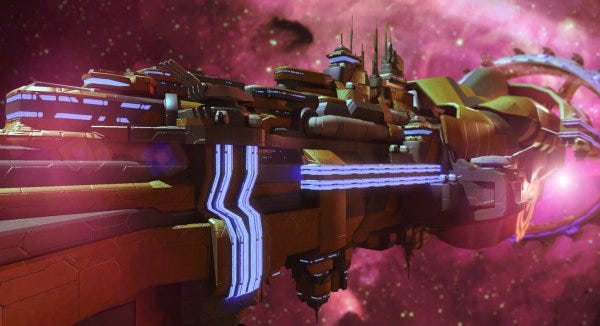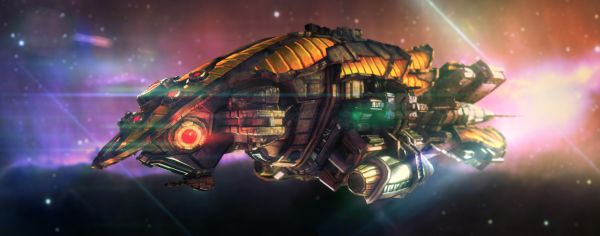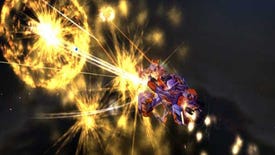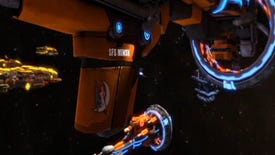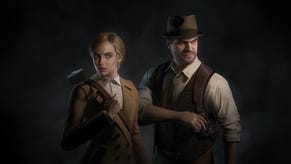A First Look At: Sword Of The Stars II
Last week I got a chance to look at upcoming 4X sequel, Sword Of The Stars II. We've all seen the fruits of the overhauled 3D battle engine, but what what of the other aspects of this many tentacled space-beast? Read on for some thoughts.
My first impression from the starting menu screen onwards was: yes, this really is still Sword Of The Stars. The clean presentation and bold UI is unmistakable, even in the rather samey realm of space 4X games. Hit the game creation screen and we're already giddy on the ether of options that the game is going to provide. A slider for the number of star systems is first up, and we drag it down to produce just a few, and then up into the hundreds. This slider is basically saying: "Does your game last a couple of hours? Or is this a 40-hour epic?" Add to this the options for average planet resources and such, and you have precise control over the scale and complexity of the game ahead of you.
That said, the galaxies are - I believe as in the previous game - all the same shape. Within that spread the planets and star systems are all mixed up every time you start a game. This means that you might face the same rough space-topography on a map, but one playthrough will still be different from another. This desire to make things different each time you play reaches deep into the game, and seems to be motivated by making the game replayable, but also unpredictable for players who have already mastered the basic game. Paradox seem to think this will help with multiplayer, since veteran players won't have as much of an advantage from having learned where things are or how the unfold as the game plays out. For example, elements of the tech tree are randomised. You might research one type of weapon, but you can't necessarily tell what tech will branch on from that. Nor can you tell precisely how long the research will take. It might take longer and demand more research, or your scientists might make a breakthrough and unlock a particular piece of hardware early. Needless to say, the tech trees are vast, too. We saw just a glimpse of it - a huge neon glowing wheel with a dozen or so options, each one opening into a large sub-tree of its own.
What this means for the level if skill that players are able to bring to the game is interesting. It's a flattering off through randomisation that doesn't seem to eat into the fairness of the game. No blasting your way through acutely learned tech-builds here, because there's always going to be some room for things not going as planned. I really like this idea, and I'm surprised we don't actually see more innovation in game standards like the tech-tree.
Anyway, real-time space combat is back, of course, and the ship-design system is suitable impressive. You can define the loadouts and specifications for all ship types, from tiny little scouts and interceptors, up through larger and more flexible cruisers, through the mighty dreadnoughts and up to leviathans, which are their own little deathstar. All these things are hugely customisable, dependent on where your civilisation is in the tech-tree, and it all feeds into the actual hands-on space combat events.
That 3D space combat engine is meticulously detailed, with the ship models all taking specific damage to whatever area is actually being hit. This is a space combat game where use of space is actually essential. Rolling your ship to take fire from a flank that hasn't already been battered by the enemy becomes an key move, for example. The UI is interesting here, too, because every ship has its own little readout bubble of stats around it. Zoom out and this becomes little more than how their shields are holding up, but zoom in and you get an exact breakdown of all aspects of how that ship is doing, plus you get to look at its beautiful super-structure being scarred by enemy lasers. It's neat design.
The rest of the game seems to operate largely as you'd expect from a 4X game, and just as you'd expect if you've played Sword Of The Stars. You explore, colonise, terraform, and have to balance how hard you harvest a world vs population growth, and how much you push its development versus climate damage. Kerberos do have a couple of susprises planned however. One of these is that ship range is not now limited simply by energy costs - they can't just roam as far as they like - they are instead tied to a specific base. This means that while fleet X might be able to capture system Y, you're going to have build another base - and another fleet - if you want to get to far away Z, which is out of the original fleet's strike range. It's a small change, but the kind of thing that alters strategy in an interesting way. I think it makes it rather more realistic, too, with fleets operating in their own region, as they do in naval operations in the real world.
The other surprise, which we've known about for a while, is that Kerberos plan to introduce a new race. All the races in Sword of the Stars play differently, although the key tenets for each are the same, but apparently this latest addition will play "unlike any other", so I will be intrigued to learn what that actually entails. Hopefully the new race won't be so different that everyone wants to play it in multiplayer, of course, because it's the drop-in-drop-out campaign that sounds like the best bit of Sword of The Stars II. The games can be set up so that you can play a vast 150-star galaxy over the course of a series of weekends, with AI capable of taking over if and when anyone can't be there to take their turns. I wonder how many people actually find time to play these vast campaigns, but I know it was the kind of thing I relished as a younger man, when I had more nerdy-needs, and a lot more spare time.
Whatever your time constraints, however, Sword Of The Stars II could be quite the thing. We'll find out if it is in September.
